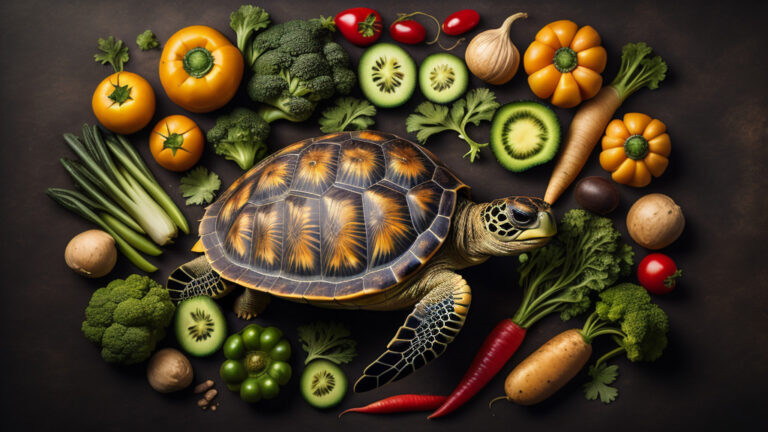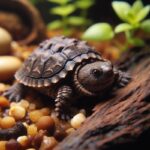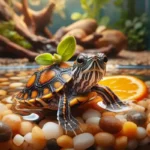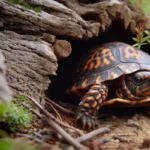A well-balanced pet turtle diet is essential for maintaining the health and happiness of these interesting animals.
Turtles make wonderful pets as they are low-maintenance, quiet, and fun to watch as they explore their surroundings.
Yet, just like any other pet, they need appropriate care and nutrition to flourish.
In this article, we’ll delve into the top 10 foods that should be included in your pet turtle’s diet to ensure their well-being, along with additional details to help you better understand their dietary needs.
Leafy Greens
Why they’re great: Leafy greens are packed with essential nutrients like vitamins A, C, and K, as well as minerals like calcium and iron.
They’re also low in calories and high in fiber, making them an ideal staple in your turtle’s diet.
The fiber content aids in digestion, while the calcium helps to maintain a strong shell and bones.
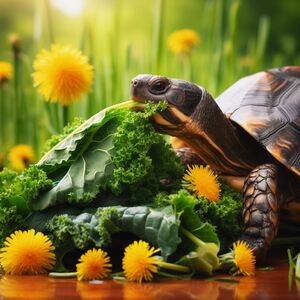
Try these: Kale, collard greens, mustard greens, and dandelion greens are all excellent choices for your pet turtle. Rotate between different types of greens to provide a variety of nutrients.
Be sure to chop them into bite-sized pieces for easy consumption and remove any tough stems that could be difficult for your turtle to chew.
Vegetables
Why they’re great: Vegetables provide essential vitamins and minerals that help keep your turtle’s immune system strong and support healthy growth. They also offer a range of textures and flavors that can keep your turtle’s diet interesting and engaging.

Try these: Carrots, bell peppers, zucchini, and squash are all great options for your turtle’s diet. Sweet potatoes and green beans can also be included occasionally.
Cut them into small pieces and mix them with leafy greens for a nutritious and colorful salad. Be sure to avoid vegetables high in oxalates, like spinach and beet greens, as they can interfere with calcium absorption.
Fruits
Why they’re great: Fruits are a natural source of essential vitamins and antioxidants that can help protect your turtle’s health. They can also provide a sweet treat and a source of hydration for your pet.
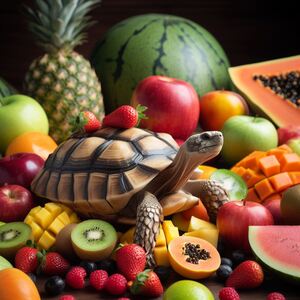
Try these: Berries, apples, and melons are all turtle-approved fruits. Papaya, mango, and kiwi can also be offered occasionally.
Remember that fruits should be given in moderation, as they can be high in sugar, which can lead to health issues if fed too frequently.
Be sure to remove any seeds or pits from the fruit before feeding it to your turtle. Additionally, always wash the fruits thoroughly to ensure they are clean and safe for your pet to consume.
Aquatic Plants
Why they’re great: Aquatic plants are a natural part of many turtles’ diets in the wild, and they can provide additional nutrients and enrichment for your pet. They also help to oxygenate the water in your turtle’s tank, contributing to a healthier environment.
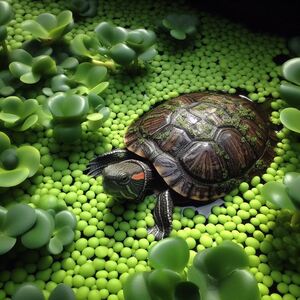
Try these: Water lettuce, duckweed, and water hyacinth are all great choices for your turtle’s tank or pond.
Anacharis and hornwort are also beneficial aquatic plants that can be included in your turtle’s habitat.
Be sure to monitor the growth of these plants and remove any excess to prevent overcrowding in the tank.
Live Prey
Why they’re great: Live prey, such as insects and worms, provide essential protein and nutrients for your turtle’s growth and development. They also offer a source of enrichment, as turtles enjoy hunting and catching their prey.
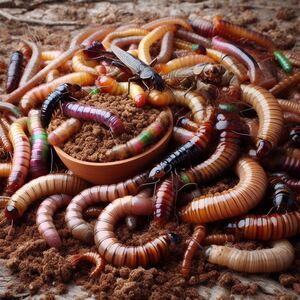
Try these: Earthworms, mealworms, and crickets are all popular live prey options for pet turtles. Silkworms and waxworms can also be offered as an occasional treat.
Be sure to gut-load your insects with nutritious foods like fruits, vegetables, and commercial gut-load products before feeding them to your turtle.
This ensures that the insects pass on their nutrients to your pet.
Feeding frequency: The appropriate amount of live prey in your turtle’s diet depends on their species, age, and size. Consult with a veterinarian or reptile specialist to determine the best feeding frequency for your specific pet.
As a general guideline, live prey can be offered once or twice a week for younger turtles, while adult turtles may require less frequent feedings.
Remember that a balanced diet includes a variety of food sources, so be sure to also provide fresh fruits, vegetables, and other food items mentioned in this post.
Commercial Turtle Pellets
Why they’re great: Commercial turtle pellets are specifically formulated to provide a balanced diet for your pet, making them a convenient and reliable option.
They contain a mix of proteins, vitamins, and minerals that cater to the nutritional needs of turtles.
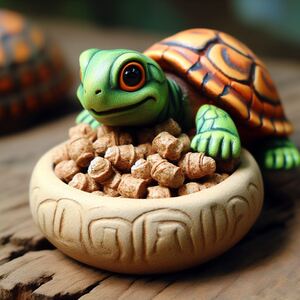
Try these: Choose a high-quality turtle pellet brand, such as Mazuri, Zoo Med, or ReptoMin, and follow the feeding guidelines on the packaging.
Keep in mind that pellets should be used in conjunction with fresh foods to provide a well-rounded diet for your turtle.
Calcium Supplements
Why they’re great: Calcium is crucial for maintaining a turtle’s strong shell and bones. Adding a calcium supplement to your turtle’s diet can help ensure they get enough of this essential mineral.
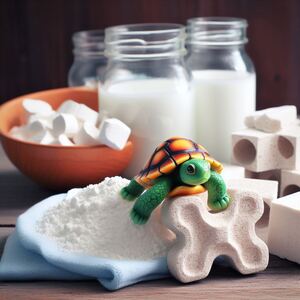
Try these: Cuttlebone, calcium blocks, or powdered calcium supplements can all be used to supplement your turtle’s diet.
Place a piece of cuttlebone in your turtle’s tank for them to nibble on, or sprinkle powdered calcium on their food once or twice a week.
Fish
Why they’re great: Fish provide a great source of protein and omega-3 fatty acids, which are essential for maintaining a turtle’s overall health. They also offer a source of enrichment, as turtles enjoy hunting and catching live fish.
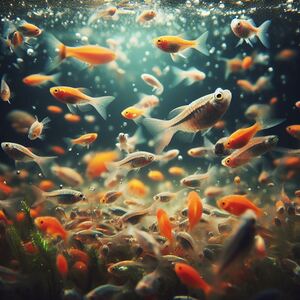
Try these: Small, whole fish like guppies, minnows, or goldfish can be offered as an occasional treat for your turtle.
Be sure to source your fish from a reputable supplier to avoid introducing parasites or diseases to your turtle’s environment.
Shrimp
Why they’re great: Shrimp are another excellent source of protein and can provide a tasty treat for your pet turtle. They also contain essential minerals like iodine, which supports proper thyroid function.
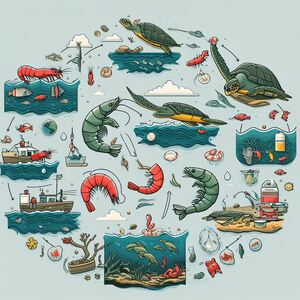
Try these: Offer your turtle cooked, unsalted shrimp as an occasional treat. Be sure to remove any shells before feeding.
You can also offer freeze-dried shrimp, which can be found in pet stores and are specifically formulated for turtles.
Snails
Why they’re great: Snails are a natural part of many turtles’ diets and can provide essential nutrients like calcium and protein. They also offer a source of enrichment, as turtles enjoy hunting and catching live snails.
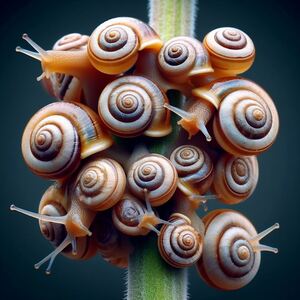
Try these: Offer your turtle small, live snails as an occasional treat. Be sure to source your snails from a reputable supplier to avoid introducing parasites or diseases to your turtle’s environment.
You can also offer canned or freeze-dried snails, which are available in pet stores.
Conclusion
In conclusion, a balanced and varied pet turtle diet is essential for keeping your turtle happy and healthy. By incorporating these top 10 foods into your turtle’s meal plan, you can ensure they receive the proper nutrition they need to thrive.
Always consult with a veterinarian or a reptile specialist if you have any concerns about your turtle’s diet or overall health.
Remember to also provide clean water and a suitable habitat for your turtle, as these factors play a significant role in their overall well-being.
Best of luck in providing a nutritious and balanced diet for your pet turtle!
